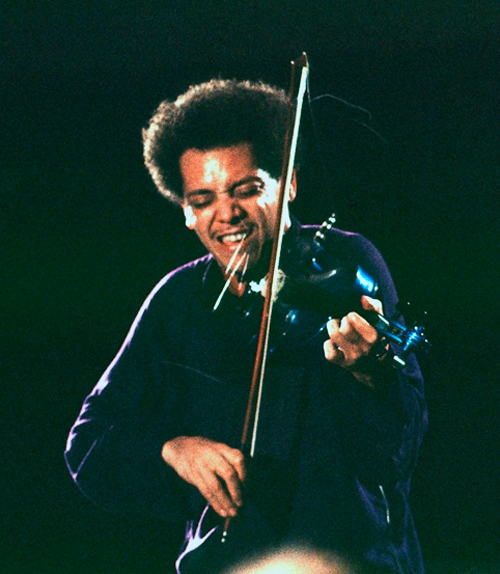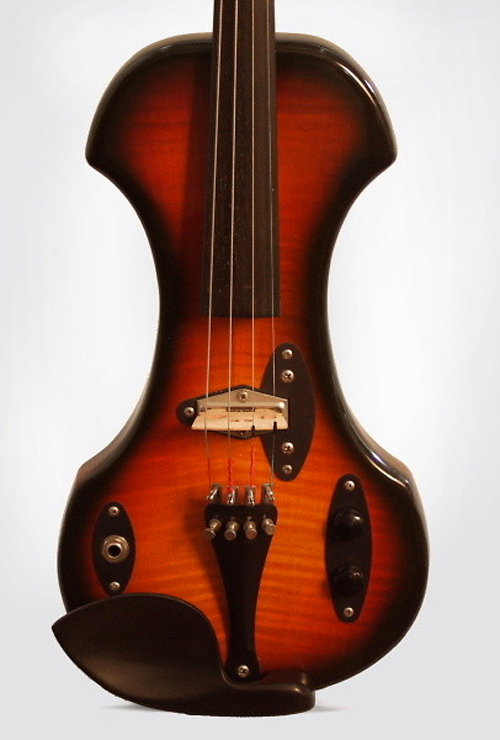Think "violin" and thoughts of a properly-attired man or woman playing in an orchestra or performing on The Grand Ole Opry probably come to mind.
Over the years, however, the instrument has crept into rock music in an amplified version. With the advent of the solidbody rendition of the instrument, the electric violin was truly ready to rock. Let's explore the history of electric violins:
The First Electric Violins
Electric violins first entered the market in the 1930s and 1940s, manufactured by companies such as the Electro Stringed Instrument Corporation (founded by George Beauchamp who invented the bakelite Electro Violin), National, and Vega, who released a solid body in 1939.
Skeleton–framed electric violins, somewhat similar to the ones made today, were manufactured in the early 1930s as well.

According to violinist and luthier Mark Wood, one surprising company got in the game.
"In the 1930s, there was an electric violin built by GE. It was obviously unplayable. It had this megaphone attached to it to amplify the sound.
A guy named Joe Venuti, a jazz violin player of the ‘40s and ‘50s, had a thing that attached to his acoustic instrument called a DeArmond [slightly different than what guitarists think of]. It was sort of a microphone that attached to the instrument. That was the most commonly used electric technology."
Since these instruments weren’t solidbody, they suffered from the same unwieldy feedback and inferior tone that plagued the recently electrified hollowbody guitars of the time.
While other violinists such as Stuff Smith also played amplified versions of the instrument within a jazz format, it wasn’t until the late ‘60s - with the rise of rock music and such electric guitar playing trailblazers as Jimi Hendrix - that the electric violin began spawning its first true rock heroes.
Electric Violin Enters The Rock Age
Frank Zappa’s genius incorporated humor, social commentary, and complex arrangements. But one bit of acknowledgement that often gets overlooked was Zappa’s employment of two talented electric violinists during the late-‘60s and early-‘70s: Don "Sugarcane" Harris and Jean-Luc Ponty.

Frank Zappa & The Mothers Of Invention
It was specifically on the 1969 Zappa album Hot Rats that Harris first left his mark. His playing on the track "Willie the Pimp" proved that violin could indeed fit inside the realm of rock.
Not long after in 1973, Ponty showcased his violin skills on another Zappa album, Over-Nite Sensation, with the tune "Fifty-Fifty."
After his emergence with Zappa, the French native signed on with the Mahavishnu Orchestra. Their 1975 release, Visions of the Emerald Beyond, offers an entire album’s worth of incredible rock and fusion electric violin.
There had been an electric violin player before Ponty in the Mahavishnu Orchestra who also broke ground: Jerry Goodman. It was Goodman’s playing in particular that served as an inspiration for up-and-comers, including Wood:
"With Jerry, there was a recording of the Mahavishnu Orchestra live at a big festival, called Mar y Sol, in Puerto Rico, in 1972 [titled Mar y Sol: The First International Puerto Rico Pop Festival]. The track is called ‘Noonward Race.’ His violin solo was unbelievable. That was the moment where I realized, I’ve got to play like this."
If you’re looking for other examples of violinists in rock, here are a few more memorable recordings:
"Running Dry" by Neil Young (drone-like solo performed by Bobby Notkoff, who was part of the Crazy Horse precursor band the Rockets)
"Baba O’Riley" by The Who (frenetic ending courtesy of Dave Arbus, who was a member of UK prog rockers East of Eden)
"Dust in the Wind" and a variety of other tunes by Kansas (played by Robby Steinhardt)
"Losing It" by Rush (provided by former FM fiddler Ben Mink)
Solidbody Electric Violins
While Harris, Goodman, and Ponty were helping introduce electric violin to rock audiences, their instruments were mostly just acoustic violins painted a different color with a pickup added.

In 1958, Fender manufactured Leo Fender's design for an electric violin in a snazzy sunburst finish. However, this early attempt at a solid body violin did not catch on, which led other violin luthiers to attempt to fill the void. Fender's violin would get reissued by CBS in 1969 [The reissue is what' picture in this article].
"Every night, I would go out and play with some rock n’ roll band, and I’d build a new violin to go out and try," recalls Wood, who was experimenting at his father’s woodshop in Port Washington, New York.
"I’d be performing, going, ‘Oh, I’ve got to move this, I’ve got to sand this, I’ve got to cut this off.’ So everything about the instrument reflects the way I heard music, as opposed to being some piece of sculpture."
Wood Violins would eventually become one of the premier manufacturers of electric violins, violas, and cellos throughout the world, offering five-string, six-string, and seven-string models, plus a self-supporting floating violin.
Today, there are more companies producing electric violins than ever before, with a range of models including the Barcus Berry Vibrato-AE Series BAR-AEG acoustic-electric violin, the Cecilio 4/4 CEVN-2BK solid wood electric silent violin, and the Yamaha silent electric violin, among others.
The electric violin has left its mark across a variety of different styles in the past decade, as exemplified by the emergence of Judy Kang (Lady Gaga), Martie Maguire (Dixie Chicks), Jimmy Herman (Carrie Underwood) and Asha Mevlana (Trans-Siberian Orchestra) to name but a few.
If you’re a violin player who’s been looking to take a breath from the classical and acoustic world, the world of amplified music waits with open arms.
Thanks goes to commenter Ben Heaney for sharing some clarifications about the early history of electric violins.
